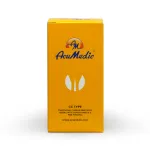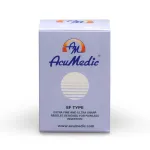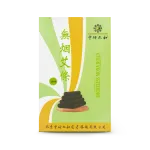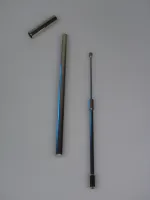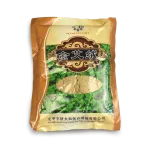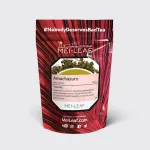Origin: Phoenix Cottage, Phoenix Mountain, Guangdong, China
Type: Oolong
Harvest: Autumn
Altitude: 1000m
A medium to dark oxidised Oolong Grown in Phoenix Mountain in Southern China. This is one of China's oldest and most famous teas and was first cultivated about 1000 years ago. It is made from semi-wild trees which are over 100 years old and charcoal roasted for a richer flavour. The result are long, curled, dark amber leaves which brew the most delicious tea.
The cultivar used to make this tea is usually Shui Xian which is the same as Da Hong Pao. However, there are 2 types of Phoenix Oolong - ones made from cloned tea garden plants and the other made from single bushes grown from seeds. Sometimes this tea is referred to as Dan Cong which literally means 'Single Bush'. But not all Phoenix Oolong is actually a Dan Cong, in fact most tea buyers will buy garden bush tea which is being sold as single bush. Similarly, any tea tree that is grown from a seed could be called Dan Cong so this name is a bit erroneous.
Whatever the details of the name, one thing is for sure, the flavour difference between garden Phoenix Oolong and true Dan Cong Phoenix oolong is remarkable. This is because of a few factors:
1. Garden tea is younger
The best tea comes from leaves that have high mineral content. The younger the tea bush the smaller the roots which means that they cannot absorb many minerals from the soil. Dan Cong tea trees are older and because they have been started from seed, have a very strong trunk to make deep roots and absorb minerals.
2. Garden tea is bunched together
Because the garden tea is cultivated together, each plant is competing with many neighbouring tea plants for the same minerals so they just can't get as much. Dan Cong is seeded sporadically in amongst rocks and other plants so there is less competition.
3. Variety of vegetation
Garden tea has almost no variety of vegetation. Semi wild Dan Cong however has plenty of vegetation and rocks around it. As the plant leaves fall or the rain filters through the rocks the soil is enriched with more variety of nutrients for the tea to absorb. This allows the tea to take on some of the characteristics of the nearby fruit trees flowers and rocks.
4. Clone vs Seed
Garden tea is cloned tea made from cuttings. This produces an identical genetic version which allows for a more consistent flavour. However, seed grown Dan Cong has its own individual genetic makeup which creates more interesting and unique flavours.
5. Harsher environment
The semi wild Dan Cong Phoenix Oolong grows on steep and rocky mountains (it is called a rock oolong). This puts the plant under stress which means that the tea grows slowly. The slower the growth the richer the mineral content in the leaves making a more powerful and fragrant drink.
Because of the genetic variation and the rich diversity of the vegetation, true Dan Cong Phoenix Oolong has a large variety of flavour profiles. Tea farmers have tried to define them in groups pomelo flower, magnolia, ginger flower etc. Our tea is Honey Orchid.
Our Phoenix Orchid Oolong is made from true Dan Cong (Single Bush) semi wild trees that are over 100 years old. With this mineral rich raw material the tea is processed by hand for a few days:
1. Outdoor withering - to begin to reduce moisture and allow flavour compounds to interact as the cell walls begin to breakdown.
2. Indoor withering - to slowly reduce moisture for further flavour development.
3. Oxidation - over about 12 hours the leaves are alternately shaken by hand in bamboo containers and left to sit and oxidise. The process is repeated up to 6 times until exactly the right level of oxidation is achieved. This is judged by eye and nose.
4. Pan Firing and Rolling - the leaves are heated in small batches on large hot pans to deactivate the enzyme which contributes to oxidation. They are fired at about 140 degrees then rolled by hand to breakdown the cell walls and release tea juices. They are fired again at about 120degrees and rolled again to make beautiful strip leaves that are covered in delicious leaf juices.
5. Drying and Roasting - the leaves are dried in bamboo containers over hot charcoal. They are dried at high temperature (about 80 degrees) to give a deep and thick fragrance. After cooling they are heated again at lower temperatures (50 degrees) until completely dry.
The result of all this work is a unbelievably rich, and fragrant tea full of peach, orchid and lychee and a satisfying quench of rock minerality. The finish is gentle but long as the minerals coat your throat and tea vapour rises for hours after drinking.
Directions:
For average brewing use about 3g for 300ml of water. Use very hot good quality water (about 95 degrees). Infuse for about 90 seconds and reinfuse a few times. We recommend that you try to brew this tea Gong Fu style. Use a small pot and use 5g of tea per 150ml. Brew for about 10-20 seconds and you can reinfuse about 10-15 times. This is really a tea to savour so wait until you have some space to sit and appreciate it.
For details on correct brewing check the Tea Brewing Chart and watch the Video Guide to Brewing Tea.
Indications:
Here are just a few known health benefits associated with drinking oolong tea: Lowers Cholesterol – Aids weight loss – Helps digestion.
